Another Postcard from Detroit
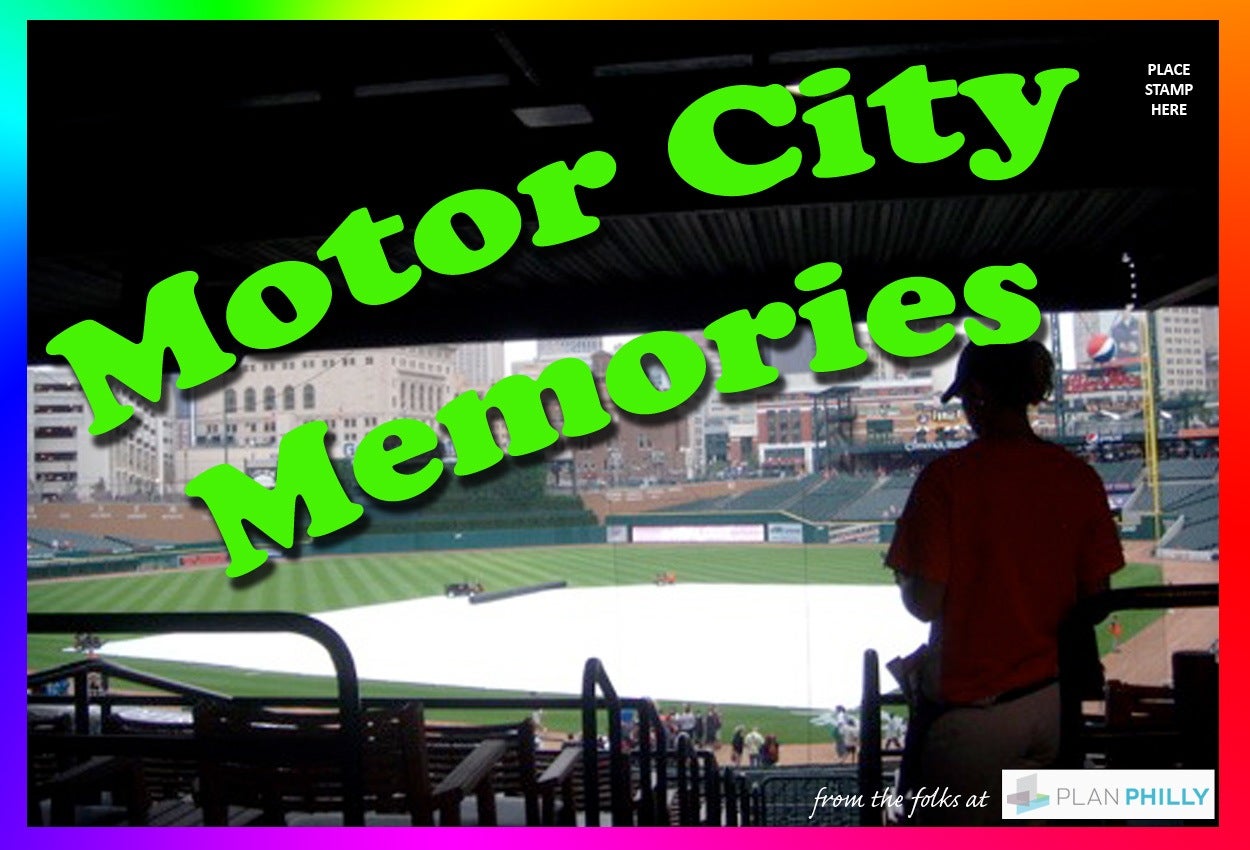
Photo: Comerica Park, opened in 2000, is the epitome of a downtown baseball park. Meanwhile, the on-again, off-again demolition of 1912’s Tiger Stadium is just about complete.
Aug. 10
Previous postcards: Detroit Part 1, Austin, China, San Francisco, Germany, Pittsburgh, New Orleans, New York City, Boston, San Antonio, Minneapolis
By JoAnn Greco
For PlanPhilly
Emerging from under the intricate wrought iron overhang of the newly-reopened and renovated (to the tune of $200 million) Westin Book Cadillac Hotel in downtown Detroit, a visitor is thrust smack into urbanity. A muscular network of wide and notably litter-free boulevards looks promising. Tall buildings loom, and planters bloom, alive with dancing yellow daylilies and purple balloon flowers.
This could almost be Chicago, right down to the familiar cross street at the corner: Michigan Avenue. (Yes, it’s the very same one.)
A closer look at the row of stores across the way, though, reveals that every last one of them is abandoned and boarded up. Where to go instead? A block to the west, the concrete swoop of the city’s famed “people mover” beckons, and a little red caboose makes its way into a striking contemporary structure with tent-like canopies and cable-railed stairways. The brand-new Rosa Parks Transit Center, designed by Parsons Brinckerhoff Michigan, puts Philadelphia’s grimy and sad bus terminal to shame.
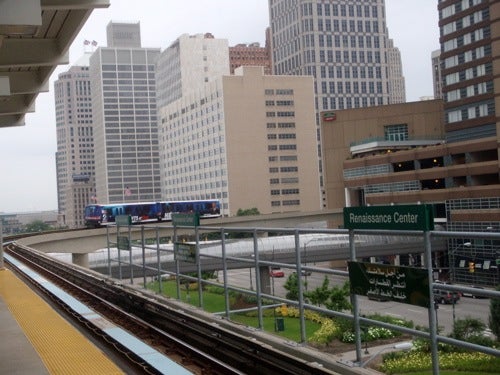
Detroit’s famous “People Mover” is a one-way, three mile loop that makes 13 stops and costs 50-cents. In June, some 200,000 riders took advantage of its prompt and speedy ride.
But back outside, a distinct police presence is felt, with three cars parked alongside the terminus, and several officers, wearing uniforms marked “Gang Squad” perched on corners. Other than the cops and a few down-on-their-heels stragglers, the streets are empty.
Not far from here, two eateries — the unlovely storefronts of American Coney Island and Lafayette Coney Island– lean grumpily against each other, periodically proclaiming themselves to be more original and older than their neighbor. Yes, Detroit has its own home-grown, disgusting fast food (the ubiquitous “Coney Island” hot dog– chili, onions, mustard) and a requisite rivalry to go with it.
Rather than Chicago, Detroit suddenly seems reminiscent of Philadelphia, as it was pre-Center City District, pre-Rendell, pre-Next Great City. Thankfully, our downtown was never this devoid of life and fortunately we were never a one-industry town.
But that industry – or the wealth and prominence it has brought Detroit – has been a huge blessing, too. And in the future, it could wind up being a solid foundation from which to pursue (if not by choice) a new direction.
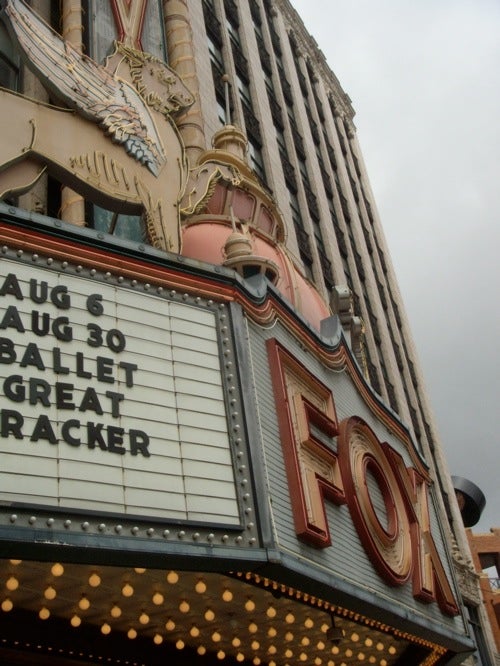
The Fox Theater is the most splendiferous of Detroit’s movie palaces and, indeed, the second largest such house in the country, after Radio City Music Hall. These days, the “Cambodian Gothic ” (as a guide laughingly dubbed it), maintains a schedule of live performances.
There’s a stellar collection of Art Deco skyscrapers (hmmm…no height caps, apparently), and a rich array of cultural attractions (many aligned City Beautiful-style about two miles from downtown). Also here: a half-dozen intact downtown movie palaces turned into performing arts venues (Save the Boyd!), several auto magnate mansions, and an architectural mecca, the Cranbrook Academy of Art, training ground for some of the 20th-century’s most important players in the field, including Edmund Bacon.
So many great buildings and such much design know-how: something has to happen soon.
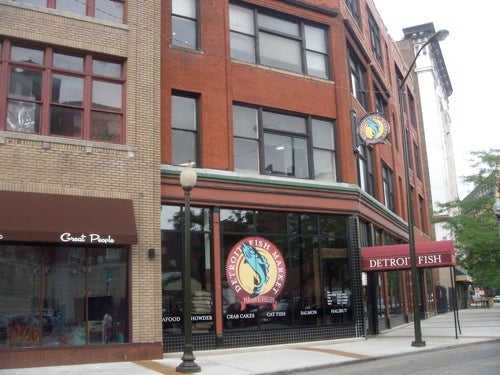
The downtown neighborhood of Harmonie Park has been rebranded Paradise Valley, with a few eateries and vintage clothing stores moving in to try and create a walkable, mixed-use community.
And it is, at least downtown. With new office buildings, an increased loft conversion rate (some 6,000 folks now call the square-mile home), several close-by and thriving ethnic neighborhoods, a sprawling 120-year-old outdoor food market, and a host of hotel projects, Detroit is positioned on the corner of hope and promise, pretty much where Philly was 15 or 20 years ago.
It’s even got a threatened arts organization (the Michigan Opera Theatre) and a baseball team that last won the World Series in 1984.
As in Philadelphia, the downtown is tidily encompassed within tight boundaries, in this case, three freeways and one river. Even though 75,000 workers come here each day, the area has thus far escaped the notice of the national chains, a fact that locals bandy with a mix of boastfulness and defiance. “When the Hard Rock concept got going, we were one of the original cities chosen as a potential locale,” says Jeanette Pierce, the 28-year-old co-founder of Inside Detroit, a tour operator whose mission goes beyond sightseeing to advocating for getting people to live downtown.
But despite the city’s place in rock history– from Motown to Eminem– “they didn’t come until 2003,” she continues, pointing to the restaurant’s sign, a mockup of a guitar used by Ted Nugent, another hometown rocker. “We wound up being something like their 187th outlet, and to this day they remain the only major chain in town, not including things like Starbucks or McDonald’s.
“We do have a lot of retail,” Pierce continues, again in that almost-petulant tone of defensiveness and pride that sounds familiar to a Philadelphian’s ears. “We just don’t have a Gap on every other corner.” An enthusiast who’s already lived in three different apartments downtown, Pierce asks rhetorically: “Where else can I walk from my 1,100-square-foot two bathroom/two bedroom $900 apartment to what’s been called the fourth-best city park in the country, or choose from 13,000 theater seats?”
Not to mention, she adds, the 125 or so locally-owned bars and restaurants. “They were started by people who instead of complaining, ‘Why don’t we have this, why don’t we have that?’, just go ahead and do it,” she says. Instances include the four-year-old Grand Trunk, a pub housed in an old railroad ticket office, and Good Girls Go to Paris, a tiny creperie in the recently rebranded neighborhood (they’ve got banners!) of Paradise Valley, located between Comerica Park and Greektown. The latter neighborhood, one of Detroit’s best-known, remains one of its most vibrant. Monroe Street is dotted with restaurants bearing names like Astoria and Cyprus and Pegasus, as well as the newest addition: the hotel portion of the Greektown Casino.
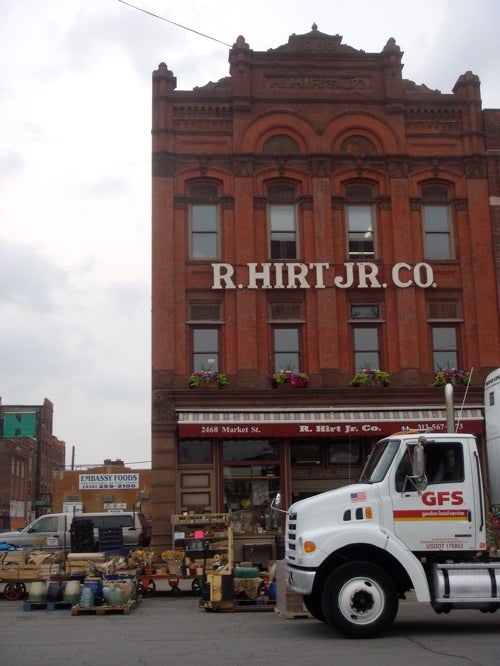
Eastern Market, a sprawling complex of historic buildings and outdoor markets, bills itself as the largest public market in the U.S., and dates to 1891.
Ah, the casinos. Detroit’s got 10 years of legalized gaming under its belt, with Greektown (owned by the Saute St. Marie Tribe of Chippewa and currently in Chapter 11) being the last to meet the mandated commitment of opening a companion hotel. Each of the three downtown casinos– the other two are Motor City (owned by the wife of local billionaire Michael Ilitch) and MGM– offer about 100,000 square-feet of gaming space (not just slots).
Originally slated as waterfront developments, the three now reside downtown. MGM’s casino was completely new-built, whereas Greektown’s is located in one of the distinctive red-brick warehouses peculiar to Monroe street, and Motor City’s is a repurposing of a corner of a Wonder Bread factory built in 1915. The new hotels, each of which looks Borgata-like, are all new-builts from the last few years, and are connected to their casinos via walkways.
Both MGM and Motor City take up extensive real estate and sit squatly on their own turf, whereas Greektown is more closely integrated into its surroundings (although restaurant owners say their businesses haven’t been significantly impacted by its arrival because they’ve always been tremendously popular).
In all cases, though, the locales make sense. The recently revitalized, and quite lovely, riverfront, while more contemporarily designed than ours is similarly lacking in things-to-do (it does offer a carousel and bike rental shack). Its sense of calm would have been completely destroyed, however, if the casinos had opened here. Anyway, a huge Caesar’s beckons across the way. . . in Windsor, Ontario, easily accessible by both bridge and tunnel.
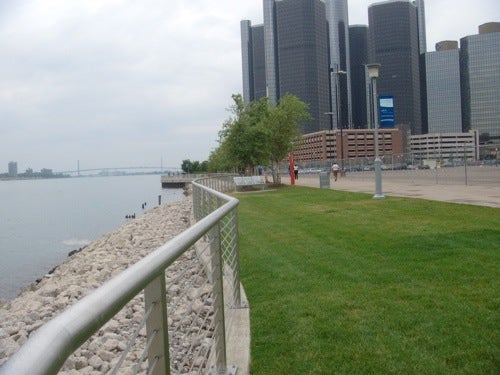
The Detroit International Riverfront (that’s Canada across the way) is prettier than Penn’s Landing, but on an ordinary day, even less trafficked.
With about 2,000 new hotel rooms added in the last two years, a very strong statewide film office, and the casinos, Detroit has readied itself to fully pursue tourism– only they envelope it into a greater whole of “entertainment”– as an alternative to the failing auto industry. “No other city in the country offers better value,” says Randy Villareal, vice president of operations at the Motor City Casino Hotel.
Whether this new industry can indeed provide a way out of the misery that’s befallen Motown – and that it still faces (Pistons star-turned bizman-turned Mayor Dave Bing recently declared the city may go bankrupt by the fall) – remains to be seen. But on a planning level, it has already resulted in some preservation, as with the Motor City casino and the aforementioned Book Cadillac, a 1924 hotel that had sat derelict and deteriorating for 20 years.
At the same time, however, the wanton razing that’s left so many empty lots continues into the 21st-century. Across the street from the Book Cadillac, the 1916 Book Tower is completely vacant, while around the corner the 1924 Lafayette office building was recently approved for demolition, despite vociferous protests.
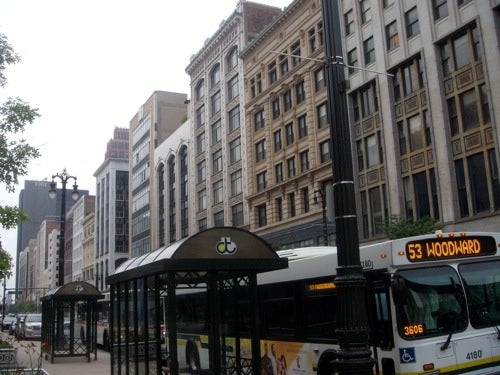
Woodward Street extends for miles through the city. The downtown portion, shown here, was once the grandest center of commerce, with its decorative, low-scale buildings playing host to a variety of department stores and shops. Now, it’s almost entirely vacant, one of the most telling testimonies to Detroit’s travails.
According to the Federal Financial Institutions Examination Council (FFIEC), the city had upwards of 57,000 vacant and foreclosed properties in 2008 (Philadelphia County had nearly 72,000, according to the FFIEC).
To put it another way, Mayor Bing told C-Span a few weeks ago that “we have 140 square miles in our city and we are probably only productively using about half of that space.” Although much infill has occurred in downtown during the last decade, surface parking lots run for blocks and blocks along its outer edge, and the “badlands” of Detroit never seem very far away.
Some experts say the answer is a downsized Detroit, For now, though, bolstered by federal stimulus money, the city seems intent on stabilizing neighborhood (with demolition an avowed part of that plan).
Nearly one year ago, the Detroit City Council approved the creation of the Detroit Land Bank Authority — an agency charged with speeding up the sale of tax-reverted properties by bestowing the ability to clear titles, and to buy, sell, demolish, or rehab derelict properties. The Authority, which recently held its first meeting, consists of seven members, appointed by the Mayor and City Council, and includes the heads of the city’s Planning and Development Department and the City Planning Commission.
A tour of at least some outlying neighborhoods reveals that not all are hopeless.
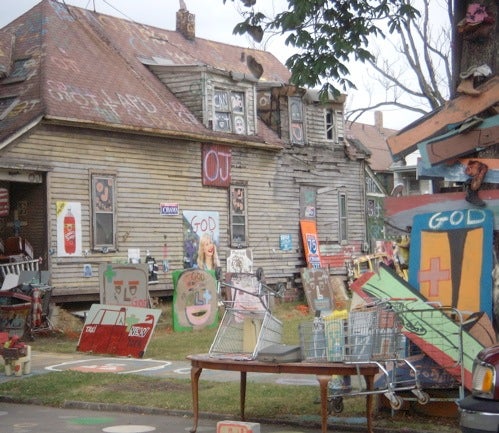
Artist Tyler Guyton first applied his patented polka dots to the ramshackle cottages of Heidelberg Street in 1986. Since then, the press has paid rabid attention, and the nonprofit project has sprawled to a few blocks, with a constant stream of sightseeers on car and on foot.
Take the self-importantly named Heidelberg Project, on the city’s east side, a two-decades outdoor art effort by the quixotic Tyler Guyton. Determined to put a “there” into one drug-plagued street of a low-income residential area, Guyton and an ever-changing corp of volunteers have over the years expanded to another street, and in the process drawn thousands of tourists.
The result: an eye-popping but ultimately wearying mishmash that’s heavy on stuffed animals and bright polka dots. It’s as if North Philadelphia’s Village of Arts and Humanities, the Mural Arts Project, and Isaiah Zagar (all similarly intentioned) had engaged in one massive paintball battle.
In other neighborhoods, urban agriculture is very hot, and stories of artists buying homes for $1,000 in attempts to colonize run-down pockets have become de rigeur among city boosters. Newcomers continue to stream into the area, too – most notably Arab Americans – and their impact in their chosen neighborhoods is evident in the small cultural centers, galleries, restaurants and shops they doggedly open.
Through it all, the city’s most potent symbol sits patiently downtown. It’s a popular sculpture of the mighty right arm of boxer Joe Louis — who grew up in Detroit and even worked for Ford’s River Rouge Plant — fully extended and ready to unleash a wallop. The “Renaissance City” is always willing to fight the good fight, the work seems to declare. Give it another decade or two, and we may all be wishing we’d bought some of those $1,000 houses.
For now, there’s a decent chance Detroiters and Philadelphians will get to know each other better in the coming months. When we duke it out in a certain October Classic.
JoAnn Greco is a Philadelphia-based journalist and editor of thecitytraveler.com. She can be reached at jphila@aol.com
WHYY is your source for fact-based, in-depth journalism and information. As a nonprofit organization, we rely on financial support from readers like you. Please give today.



